"The slaughter of unarmed children, women, the aged and the infirm was shocking. For me, I was doubly outraged that I had to discover the truth about a brave and generous people only through their deaths. Until then, I never knew Palestinian refugees existed. As a fundamentalist Christian, I had been a supporter of Israel, hated Arabs and saw the Palestinian Liberation Organisation as terrorists to be loathed and feared."
Extract from the back cover of her book "From Beirut To Jerusalem"
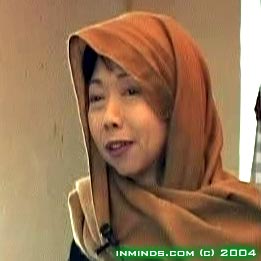
Dr Ang Swee Chai talking at a London Mosque.
(Out of respect for Islam she wore a head scarf in the Mosque)
Dr Ang Swee Chai grew up supporting Israel. Arabs, she was told, were terrorists. But in 1982, on the television she saw the relentless bombing of Beirut by Israeli planes. Shocked, her view of Israel began to change. It was then that she heard of an international appeal for an orthopaedic surgeon to treat war victims in Beirut. The petit woman - she was just under 1.5 meters - resigned her job in London, bade her husband farewell and set out on a journey to civil war Beirut, there she was to eye-witness the Sabra-Shatila massacres*.
With her husband Francis Khoo, and some friends, Dr Ang Swee Chai helped to form the British charity, Medical Aid for Palestinians (MAP), following the 1982 Sabra-Shatila massacres. In 1987, PLO chairman Yasser Arafat awarded Dr Ang Swee Chai the "Star of Palestine" the highest award for service to the Palestinian people.
In her talk, given at a West London Mosque on 10th December 2004, she shares with us some of her experiences of Lebanon and Palestine. Many of the slides she uses in her talk are reproduced below with relevant captions and a time code so that you may follow the slides with the audio.
We thank Dr Ang Swee Chai for her talk, all slides are copyright Dr Ang Swee Chai as are the extracts we have quoted from her book 'From Beirut To Jerusalem', we also like to thank Mehfil-E-Ali for their help. Any additional images used that were not part of the original presentation are marked [+] . Any additional reporting is ours and we alone are responsible for it.
* Sabra-Shatila Massacre: In September 1982, just a few weeks after the Palestinian men had surrendered their weapons under an internationally brokered peace deal, and were deported from Beirut leaving their families under the protection of an international peace keeping force, the Israeli army invaded Beirut, violating the peace treaty, and some 3000 defenceless Palestinian women and children were rounded up in the refugee camps of Sabra and Shatila and systematically murdered in cold blood. (For a repeat of this tragedy see Srebrenica in 1995 - only that time it was 8000 Muslim men who were slaughtered after they had handed their weapons to the UN forces who had guaranteed them a "safe haven").
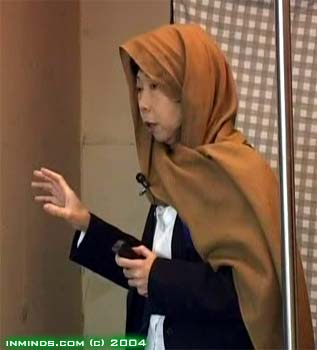
[3:20] I've called it "From Beirut to Jerusalem" because within my own heart I share this fervent wish that one day the Palestinians will be able to return from the refugee camps in Lebanon, that my friends can go back to al-Aqsa and pray as their forefathers had. Its something they all want to do but they can't do now.
The Siege
The 1982 Israeli invasion of Lebanon killed over 30,000 civilians. The siege of Beirut lasted for 70 days, Beirut was subjected a relentless barrage of air, naval, and artillery bombardment. The Israeli bombardment was random and indiscriminate. Food, electricity and water supplies were cut off - over 500,000 people were driven from their homes. The IDF calculated that they had used some 960 tons of ammunition in trying to destroy the city.
The price asked by Israel to stop the destruction of Beirut was for the 14,000 PLO fighters to abandon the city - leaving behind their families. The US brokered peace deal guaranteed the safety of the Palestinians left behind in the camps - a multinational peacekeeping force would be deployed to protect them.
The US didn't honour its word and three weeks after the PLO evacuation they withdrew the multinational force giving the green light to Israel to invade West Beirut and massacre the Palestinians in the camps.
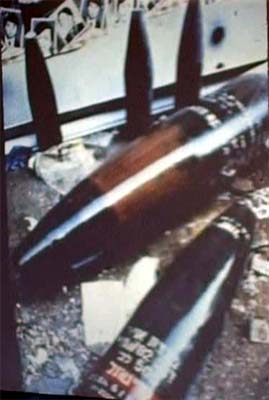
[6:30] As you can see these were some of the bombs that Israel had
- killing many people
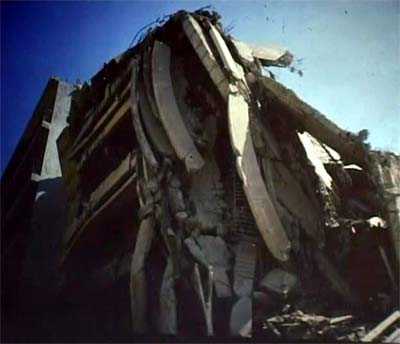
[7:40] Finally the cease-fire came and we were able to make our way across the green-line in to West Beirut. This was the Beirut I new - the Beirut for weeks before I'd watched on television - blocks and blocks of buildings being bombed out and destroyed - only this time it was real, life sized, 3 dimensional and frightening
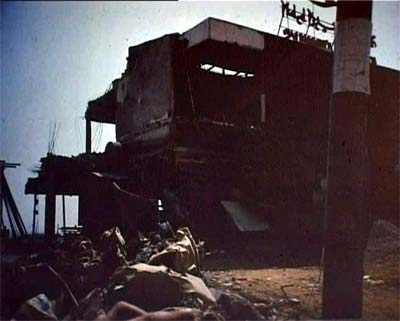
[8:10] The coast line of the beautiful city of Beirut - also known as the pearl of the Middle-East - was shelled by Israeli gun boats and reduced to wreckage.
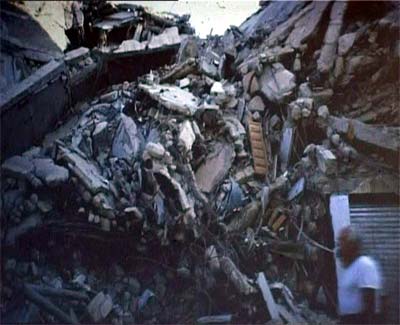
[8:20] But more frightening are the number of new weapons they tested in Lebanon - that time it was the first time Israel exploded phosphorous bombs. So that when phosphorus hits someone it just burns for days and days and then if you wash it - it will burn even more, and the victims just died of phosphorus burns. But this is a different kind - this is called a vacuum bomb. What would happen is that the bomb would go in to a centre, build up very high TNT value, and suck the whole building down - this is an 11 floor building that was sucked in to a heap of rubble, buried within it are 200 people. When I arrived and saw this for myself I know that a doctor can't do much - it is a very humbling experience... I could do nothing to help those people who were buried and killed in this one single bomb attack.
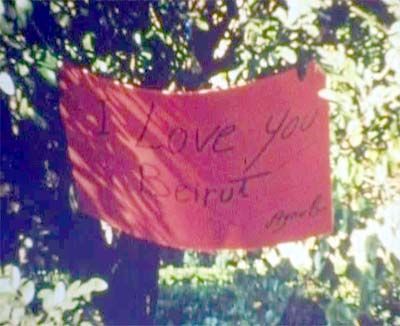
[10:40] Farewell message left by a Palestinian forced to evacuate Beirut... 14,000 Palestinians [men] were forced to leave Lebanon within the evacuation which means that 14,000 families have been broken up, because each family have given up their men - either a father or an eldest son or somebody important, leaving behind women with young children and old people with no men to look after them. In a middle-eastern culture this is a catastrophe. You can image 14,000 families and from these families you take the oldest son out, you take the father - force them to leave and never to come back. That was the price Israel demanded from the PLO in order to stop the bombing.
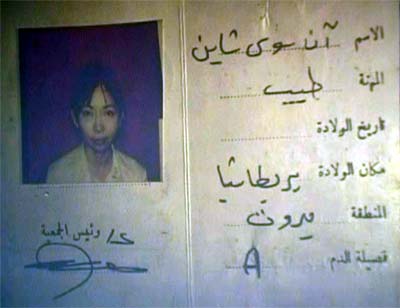
[12:40] I was seconded by the International Red Cross to join a group called the Palestinian Red Crescent Society - this was quite a culture shock to me because I am joining a Red Crescent - a Muslim organisation - but it was the beginning of a road, the beginning of a journey, beginning of a way where I learnt.. and that is my [Red Crescent] ID Card which I cherish...
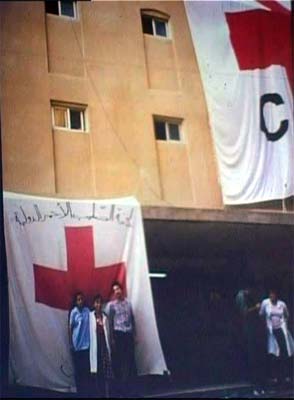
[13:15] Gaza Hospital in Beirut, inside the Sabra-Shatila refugee camp
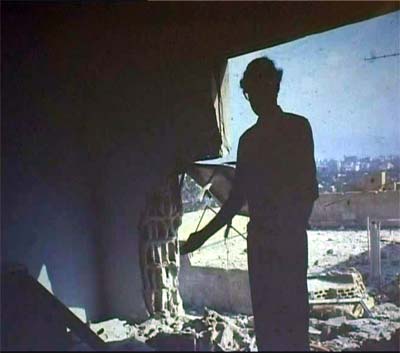
[15:00] Gaza Hospital was protected by the International Red Cross, despite that Gaza Hospital has been bombed - it was 11 floors high and the top 2 floors were blown off, the doctors quarters were shelled..
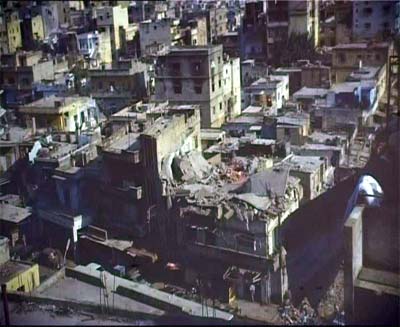
[15:25] Photo from 6th floor of Gaza Hospital. At the time the Palestine Red Crescent Society ran 13 clinics and 9 hospitals - and the Israelis had selectively bombed and destroyed every single one of the clinics and hospitals - killing patients and killing doctors...
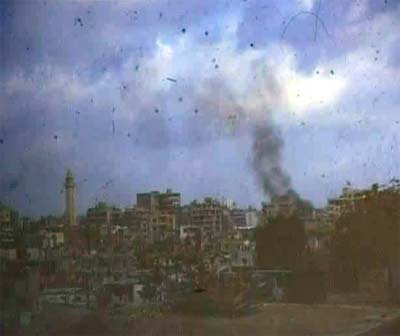
[20:30] There was 3 weeks of peace [following the PLO evacuation], then suddenly on the 15th of September something horrible happened - the international peace keeping force decided to withdraw... and israeli planes flew in and 500-600 Israeli tanks started to roll in to Beirut city [violating the peace treaty]. Before this Beirut city was surrounded by Israeli tanks but never invaded like that - the Israelis had bombed Beirut from the air and seiged the city and denied water and medicine to the people, but this time the tanks are comming - and you can see the tank shelling. [photo] You can see the Mosque in south Beirut - that was the first shell that fell - it was from an Israeli tank. They began to surround the refugee camps in all directions. By about mid-day there was streams of shell smoke comming from everywhere and everybody was very frightened knowing that something horrible is going to happen...
At 4:30pm news arrived at the Gaza Hospital that Israeli troops had invaded Akka Hospital [just outside the camp], nurses had been raped and killed, doctors and patients shot dead.
Extract from p55 & p79 of the book "From Beirut To Jerusalem"
The Massacre
The phalange militia were Israel's proxy in Lebanon, their members were recruited from the
Maronite Christian community. They were payed for, trained and armed by Israel. They were effectively an extension of the IDF, and were usually sent in to do the dirty work.
After Sharon's army had taken West Beirut and sealed off all escapes routes from the Palestinian refugee camps, Sharon ordered the phalange in. The official order from Sharon read "for the operation in the camps the phalange should be sent in"*. Knowing that the camps were full of unarmed civilians - mainly women and children, only around 150 phalange were deployed. The testimonies of the survivors suggest that both Israeli soldiers and their mercenaries the Phalange entered the camps and participated in the massacre**.
The Israelis supervised the operation from their forward command post, a six story building overlooking the camps. From there they gave logistic support and relayed orders to the soldiers on the ground. Concerned that reports of the on-going slaughter would leak out, the soldiers were ordered to continue the killing through out the night - to facilitate this the Israelis lit up the sky with flares all night long. The idea was to kill as many Palestinians as quickly as possible, before international pressure would put a stop to the operation. Over 3000 elderly men, women and children were murdered. Next the evidence had to be buried quickly - so the Israelis send in bulldozers. Houses were packed with bodies and demolished to form mass graves. One such mass grave contained a thousand bodies.
*see BBC Panorama "The Accused" 2001.
** Survivors interviewd on 22 Sep reported that
many of the soldiers who did the killing did not speak Arabic and Israeli newspapers (in Hebrew) and Israeli food rations were found left behind. A young boy, Munir, who was left for dead under a heap of 27 bodies confirmed that he has seen both Israelis and Phalange murdering people, when he was brought to Gaza Hospital on 17 Sept. (Src: 'From Beirut To Jerusalem' pgs 61, 69 & 71)
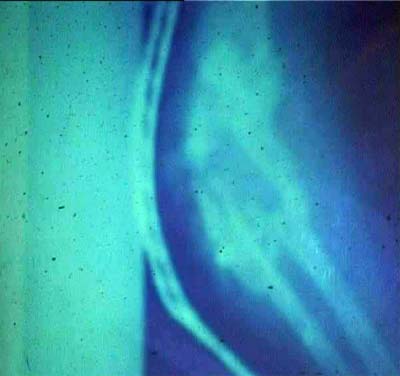
[22:20] The next morning, early in the morning after prayer time, women went to the well and water points to get water for the family and right there they were shot, some of them killed. [photo] This was the first lady that came in, with her elbow blown off, this was her x-ray.
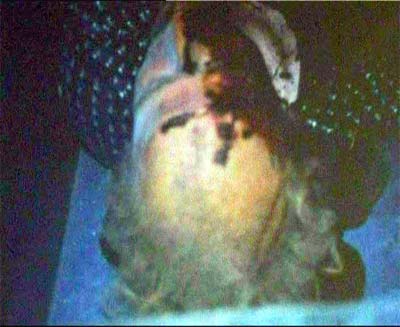
[22:40] And following her a lot of people were shot in their homes and they were brought in to the hospital - many of them died in the mortuary. By no means were they terrorists - [photo] this was an old man that lived next to the hospital - I knew him very well - they killed him.
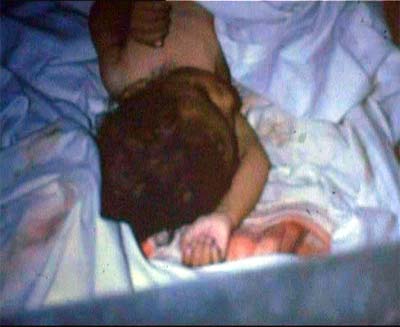
[23:00] Young children like that [photo] were dying [shot] for no reason
Giving Life
In the theatre, I operated on a woman and a child. The woman had major surgery for a gunshot wound of the abdomen. It was a difficult operation, as I had to remove a third of her liver, and anastomose - or join together - transected large and small bowels. She was waking up from the anaesthetic, when the child was brought back from the theatre recovery room. i nipped back in to see both of them and remind the nurses in intensive care to give both of them blood transfusions. I was told that the packet of blood being transfused into the woman was the last one. The child had been wounded by a hand grenade chucked into the midst of a group of little kids. He had lost a fair amount of blood through a severed splenic artery, but otherwise he was stable after his operation. Both needed blood and they were of the same blood group. The Palestinian woman overheard the nurses talking to me and asked us to give blood to the child instead of her. Then she asked for some painkillers and died shortly afterwards.
Extract from p61 of the book "From Beirut To Jerusalem"
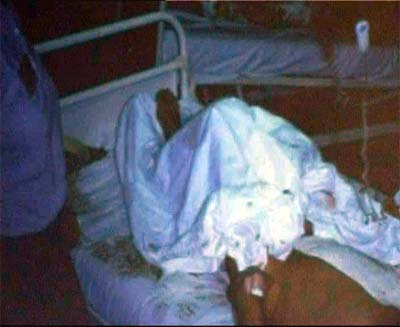
[23:05] My own nurses were also shot, and by evening the next day the whole hospital was teaming with people - about 3000 people - fleeing in to the hospital saying that gunmen had broken in to the homes of the people in the camps and started shooting whole families. They were very very frightened, they were hoping that by staying in the hospital somehow because of the foreign doctors and the International Red Cross observer status that they would be protected - but that was not true of course...
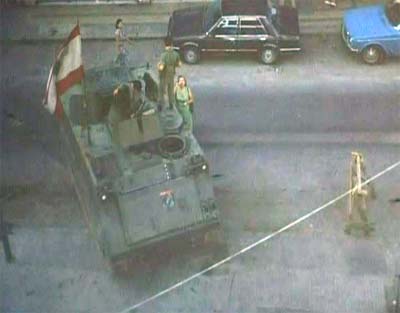
[24:30] On 18th September [72 hours in to the killing] a tank came in and ordered all foreigners out of the hospital at gun point. That was the time when we were very worried because we thought that if we are gone they will probably come in and kill our patients. But at the same time you can not argue with a machine gun and we were just forced out. And as I came out of the hospital I saw groups of women and men and children all rounded up by soldiers and while I was passing them one woman tried to give me her baby but that was not allowed and she was forced to take the baby back, and I fear the worst because for many days afterwards I came back looking for the mother and child - I couldn't find any of them.
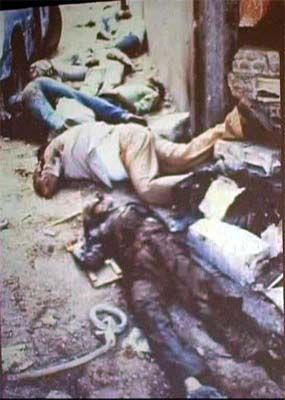
[25:30] For the first time we were out from the basement operating theatre and we can see what has happened - whilst we were operating, trying to save a few lives, the people of the camps were massacred - killed - their bodies left rotting.
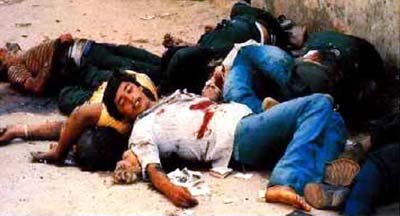 [+] [+]
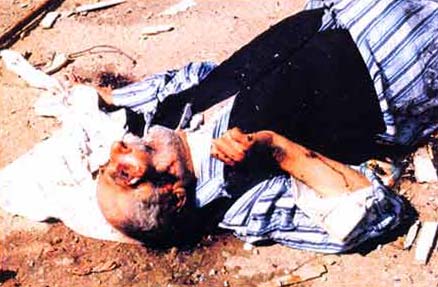 [+] [+]
Old man tortured - eyes gouged out - before being murdered
To Kill Not Enough
The truth hit me painfully...Besides being shot dead, people were tortured before being killed. They were beaten brutally, electric wires were tied round limbs, eyes were dug out, women were raped, often more than once, children were dynamited alive. Looking at all the broken bodies, I began to think that those who had died quickly were the lucky ones.
Extract from p67 of the book "From Beirut To Jerusalem".
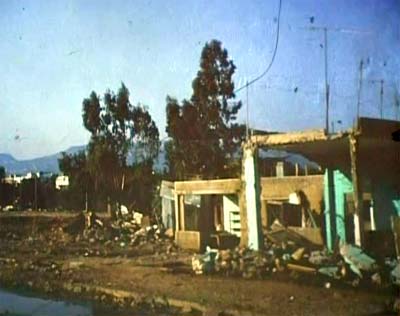
[26:45] The homes people had come to rebuild were destroyed - if you look at these houses you will find that the paint is still fresh - its just painted and probably not even dried. And if you go beyond the broken walls you find the families were broken - there was no one left - food was half eaten - furniture half smashed - the people gone - buried in mass graves.
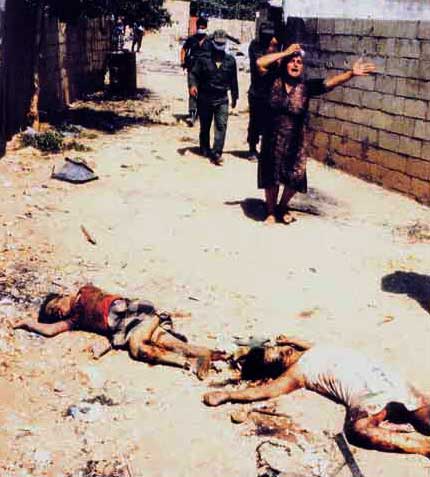 [+] [+]
A mothers agony - her children slaughtered mercilessly
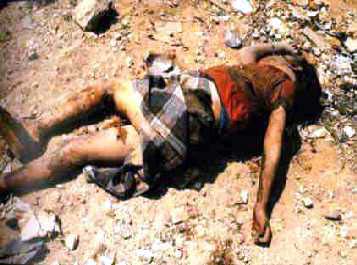 [+] [+]
For what crime was this child murdered?
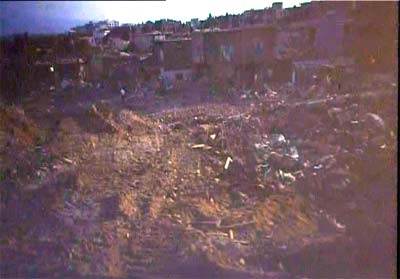
[27:20] These are mass graves. You can see the tank tracks - they have just dug up shallow graves and buried all the bodies in the rubble. They have just bulldozed all the houses - actually if you have been watching the television its very much like Jenin [below] recently in Palestine, but on a bigger scale. About 3000 people were killed in those three days, and in this mass grave alone 1000 bodies were buried there.
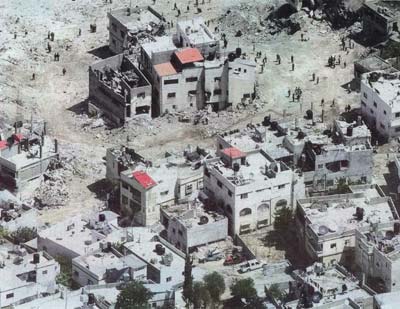 [+] [+]
The centre of Jenin after the recent Israeli massacre
- whole streets missing - destroyed - flattened
and buried under rubble
- rubble so high that the lower floors
of buildings still left standing
have disappeared under the rubble.
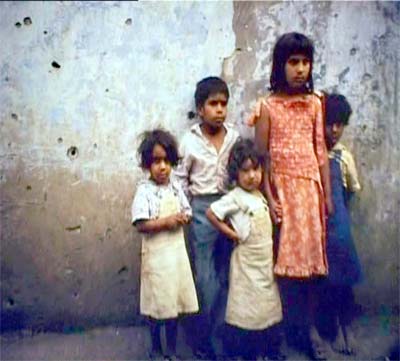
[28:10] There were orphans every where and as you walk around you see children standing in front of walls with bullet holes, where their families were lined up and killed.
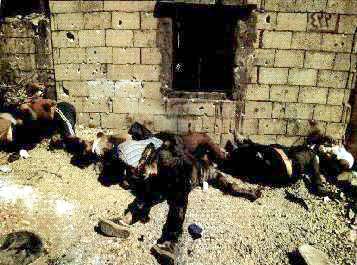 [+] [+]
Families lined up outside their homes and executed
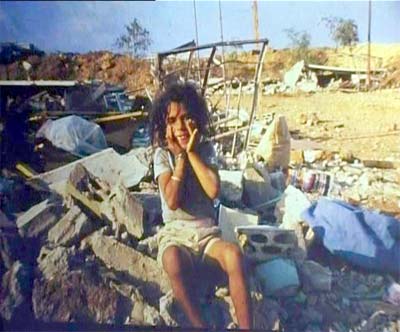
[28:35] Children without homes - there is no where to go for the coming winter
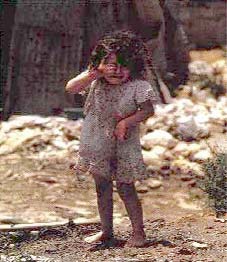 [+] [+]
The "lucky" survivors - now homeless orphans
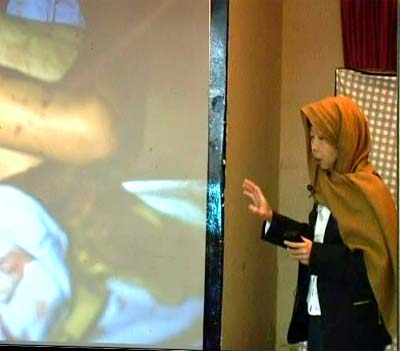
[28:45] I want to talk to you about this family because it is such a typical and yet painful event. This family was from a village near Jerusalem. Their village is completely gone - it doesn't exist anymore - when Israel was formed they found themselves in South Lebanon. South Lebanon was bombed, so the family found themselves in another refugee camp called Tel al-Zaatar in east Beirut. In 1978 Tel al-Zaatar was massacred -3000 people died. So this family escaped from Tel al-Zaatar and found themselves in Shatila camp. When the evacuation took place the family had enough - they said they were going to stay, so they stayed in Shatila camp. And the massacre came, and of the whole family 27 members were killed!
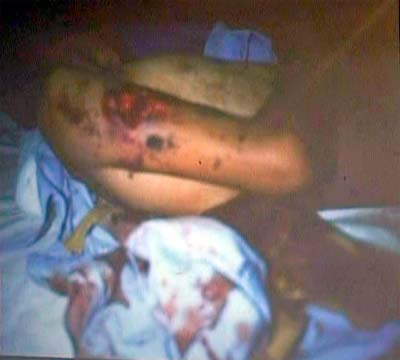
[30:10] This is Munir, at the time Munir was only 9 years old. Munir was shot 3 times together with 27 members of his family. And as the dead bodies fell on him, he fainted - which was a good thing because the gunmen thought he had died and left him alone. After they left his friends came and took him to the hospital.
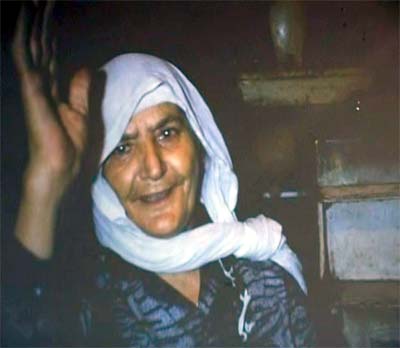
[30:50] I visited Munir's grandmother Hajjar. His grandmother at the time was in South Lebanon and when she heard that there was a massacre in Shatila the 72 year old lady was very worried so she walked 20 kilometres - all the way from South Lebanon to Shatila camp. And when she arrived she knew her family was gone. Hajjar was mourning for her family but I went in to her house because she's Munir's grandmother and I asked her what have you to say Hajjar? Then she broke out and told me all this in arabic:
Whats there left to say? There is nothing left to say.
Our flowers still blosom
and our oranges give fragrance,
our sparrows sing their usual songs,
yet my children are no where to be found.
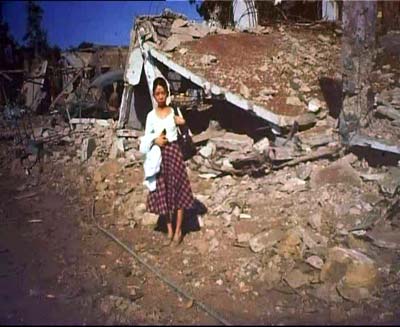
Beirut - you took all I had,
and you took my last important life,
my heart lies dead on your streets.
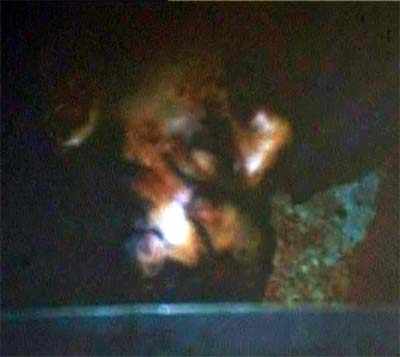
Abu Zuhair, my fine young son
was cruelly cut off from his roots on your soil.
Abu Zuhair - you who found your way
from Tel al-Zaatar
with a Kalashnikov in your hand,
to meet me Shatila,
how come you are slaughtered like a sheep?
What have I got to say?
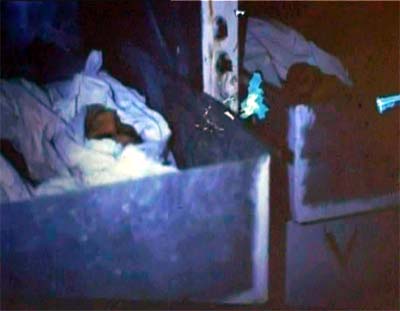
Crow of ill-omen - please,
who told you of my where abouts?
Bearers of coffins, please move slowly
so that I can see my loved ones once again
Oh God! Please wait, just wait
and Your will be done.
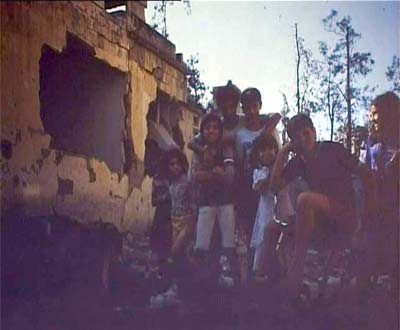
How I envy those of you who were around when my children died.
Did you let them die thirsty?
Or were you kind enough to give then a drink?
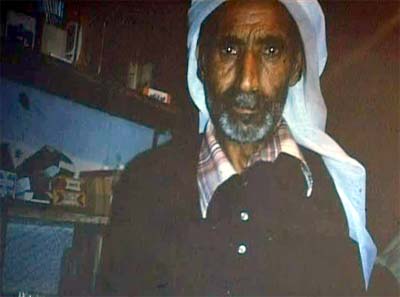
Life - what life is like to us?
Our hearts have died and our tears have dried
for all the men and women who fell.
God All Mighty give us patience,
and our children
- may our love be a lantern to Your path
and may God show me the holy way
Doctor, please go away -
you have reopened all our wounds,
we are so weary, what is there to say?
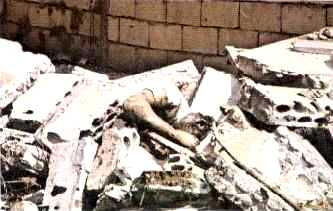 [+] [+]
[35:10] Everyday I go back to the refugee camps - to the hospital, and we walk up and down. Each time we find a new mass grave, we find bodies and sometimes, now we are talking about October, it was decaying and the stench horrendous. You cant even recognise the bodies -usually you find the identity card or a piece of jewelry or something like that, and the families identify the bodies, take it back and buried it and there was crying.
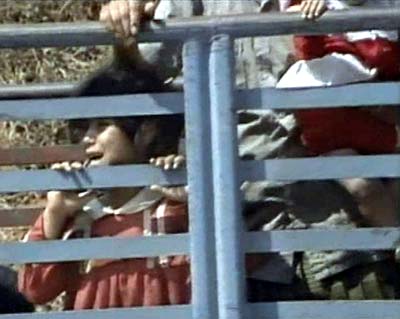 [+] [+]
Terrified women and children being taken away in a truck
(image captured by a Danish cameraman - BBC "The Accused" 2001)
The Stadium
I walked towards the sports stadium. I had not found the strength to visit this area before. At sunset, it looked hideous. People had been killed here, people were buried here: I seemed to hear their voices echoing mournfully in the wasteland. This place had been pounded incessantly by Israeli aeroplanes during the siege. During the massacre, it was occupied by the Israelis, and the camp people told me that trucks of men, women and children were taken to the stadium by the Israelis, and many had 'disappeared'.
The body of a little child I had once treated had been found in the stadium on 18 September, the day of the massacre. With other little children, he had been blown up by a hand grenade thrown into their midst. All around the stadium I could see cloths, mostly women's clothes. Angry survivors told me large numbers of women had been forced en masse to undress, and were raped by the soldiers before they were killed.
Extract from p90 of the book "From Beirut To Jerusalem".
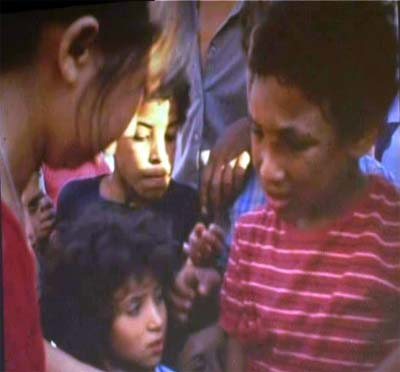
[35:40] One day something good happened, this boy whom I treated just before the massacre spotted me - little Mahmoud came out and started to put his arms around me "Dr Swee! Dr Swee!" and I said "Oh Mahmoud!", he said "we saw the soldiers take you - all the foreigners, to the UN building and thats where they killed everybody so I thought you were dead" So he was so happy and started to cry, and I realised that poor Mahmoud has lost his family - he was now an orphan.
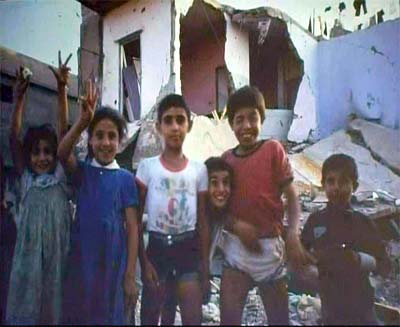
[36:15] And suddenly a whole lot of children - Palestinian children from every where began to crowd around me, and the little girl said "Doctor can you take a picture of us?" I said "of course I will".
"You must take a picture of us now because there is the Shatila camp - tomorrow maybe the camp will be destroyed and there will be no more Shatila, but al least today we are here and you can take a picture and show your friends all over the world this refugee camp and show them we are the children of Shatila". And as I began to focus the camera
they decided to put their hands up and make a victory sign and said "and we are not afraid". This picture was taken in October 1982, since then I have been back to Lebanon many times, and each time I go back I carry a copy of these pictures hoping I can find them - of course I never found any of these children. But now looking back I realise they didn't ask me bring the pictures back to them - they said take the pictures and show it to the whole world, to show the whole world how the Palestinian children of Shatila camp were not afraid. So I am showing it to you now.
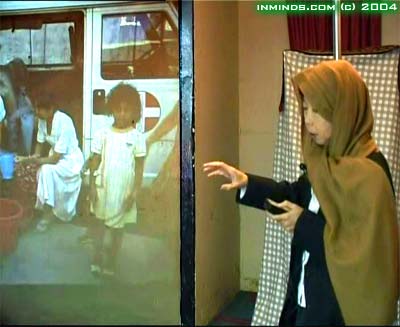
Palestinian Compassion
After the massacre, some of the very soldiers that took part in the slaughter amazingly turned up at the hospital for treatment - six of them had fallen off the rooftop of one of the camp houses while arresting Palestinians. The natural reaction was to turn them away, but before Dr Swee could do this the Palestinian administrator intervened:
...in a loud voice I told them there was no doctor around.It was easy to get them to believe me, as they assumed I was a little Asian nurse. Then I felt someone gently tugging at my white coat: it was Azziza, the hospital administrator. She wanted to talk to me in private.
'Please, Swee, you have to treat these people. I know what you are thinking. But believe me, my family have suffered so much - and I ask you to do this, for our sake. We were forced to leave Jerusalem, then the siege, then the massacre - all these wounds are still sore, but we cannot deny anyone medical care. We are the Palestinian Red Crescent Society, and our principles compel us to give medical care to all alike, even our enemies.'
Extract from p92 of Dr Ang Swee Chai's book "From Beirut To Jerusalem".
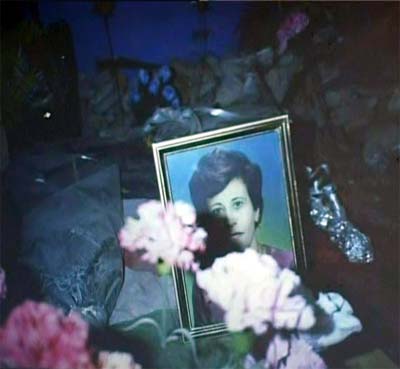
[39:10] Within a few months of our formation [of Medical Aid for Palestinians] the Palestinians were attacked - there was another camp war, many of my friends were killed and this time they were under siege so the bodies had to be buried in the Mosque - the martyrs had no where to be buried.
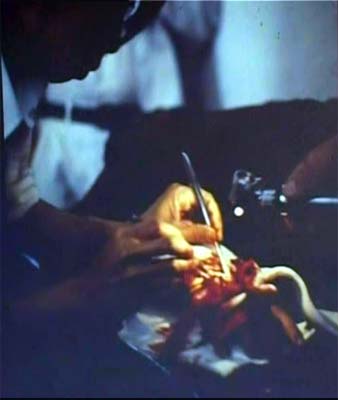
[39:40] Gaza Hospital was burnt and it was difficult to look after patients, we had to do operations without masks, without gloves, without electricity..
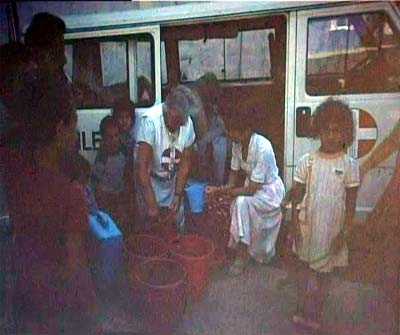
[40:00] This 82 year old lady came from Germany, all she wanted to do was get this van and drive around all the refugee camps to the displaced people and give them milk... the children love her, her name is Rita so they call her Mama Rita, and from Mama Rita to Mama Halib - meaning milk mother.
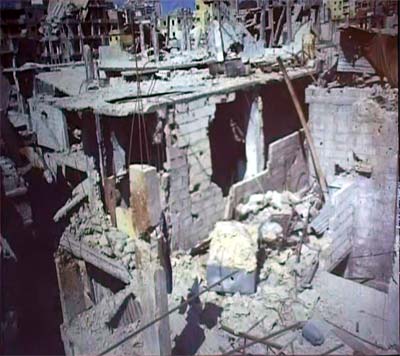
[41:00] In 1987 we were still working in Shatila, but Shatila camp has become like that [photo]. 1987 was also the United Nations international year of shelter, so 100s of resolutions were passed about how everyone has a right to a home but it by-passed the Palestinian people. The refugee camps were destroyed - not rebuilt, people lived in this and when the rains fall the whole lot collapsed and all of them had to be evacuated in to... [see below]
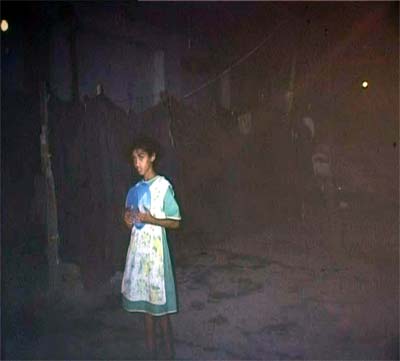
[41:40] ...shelters like this - all partitioned. So these are abandoned buildings and the UN would just put up curtains and within year back curtain would be a family. So the cycle has completed - from people in Palestine in to tents in Lebanon, and then they converted their tents in to cities, the cities were destroyed, and now their children are now back to living in this kind of shelters - grim and depressing with no future and yet it was in 1987 in one of these shelters that we learnt of the first Palestinian Intifada. The first uprising - the Palestinians under occupation in Gaza and West Bank had decided to oppose the occupation and rose up against the Israeli occupation.
First Intifada
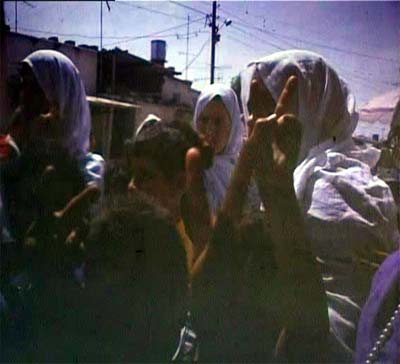
[42:40] This is the women of Gaza, and the children of Gaza. they were demonstrating before Israeli tanks. Now it takes a lot of courage to stand before Israeli tanks who can actually just shell them and kill them - but they are not afraid. So it is a very special moment when ordinary people stood up against a might military force - I think the Israeli army is the fourth largest army in the world in terms of armourments and fire power.
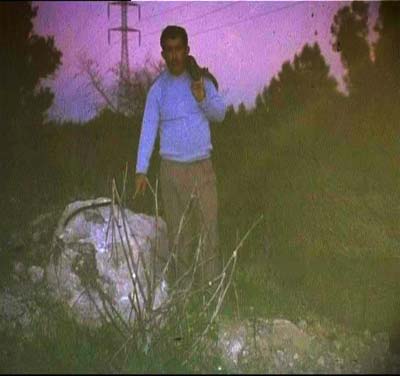
[43:20] This is a Palestinian refugee living in Jabaliya camp, but that day Abu Mohammad has taken me to this heap of rocks - that was his grandfathers home. the Israelis came and dynamited it and put a prohibition on it so that no one from his family can go and live there or rebuilt it. Now the interesting thing is that all around it trees were planted and every year millions of American pilgrims visit the Holy Land and they look at the trees planted by Israel, but it was only the Intifada that actually makes some of them look at the bulldozed building and the rubble and the homes that have been destroyed so that the trees could be planted...
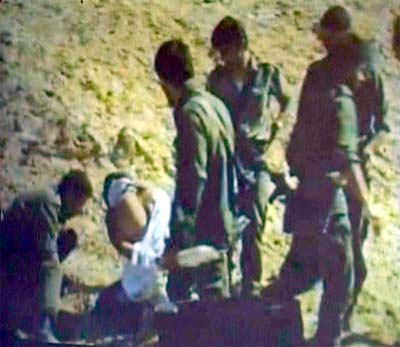
 See Video of Israeli soldiers breaking the bones of Palestinian prisoners (23s, 445Kb realmedia) (Tip: watch it after you have finished listening to the talk as the same player is needed for watching the video) See Video of Israeli soldiers breaking the bones of Palestinian prisoners (23s, 445Kb realmedia) (Tip: watch it after you have finished listening to the talk as the same player is needed for watching the video)
Breaking Bones
During the first Intifada the entire world saw footage of Israeli soldiers beating up young Palestinian prisoners, breaking their bones with large rocks, rifle butts and metal bars. Defense Minister Rabin explained in an interview with Army Radio that he had ordered his soldiers to break the bones of Palestinian stone throwers. (Its disgraceful how the media has since recast this war criminal - Rabin as a peacemaker).
The deliberate policy of breaking the limbs of Palestinians meant that victims would be crippled for a long time. A fractured limb takes a good few months to mend, and then an equally long time to be rehabilitated to full functional status. As an orthopaedic or bone surgeon, I know that there is no way to hurry the process of bone healing. If all four limb bones are broken, then the injured person will be quite useless for up to a year. Meanwhile, if he was the sole breadwinner, his family would starve.
Extract from p287-288 of the book "From Beirut To Jerusalem".
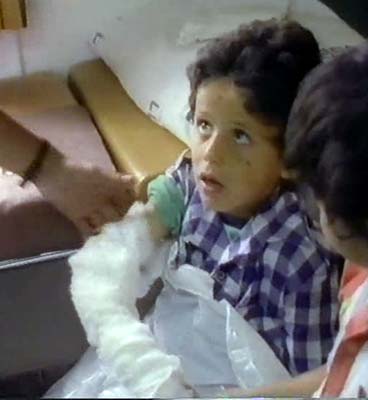 [+] [+]
8 year old Muhammad had his bones crushed by Israeli soldiers to prevent him from picking up a stone. His friend Hassan's (right) 3 year old brother was also beaten up by the soldiers, resulting in fractures. [Al-Ahli Hospital Gaza, from BBC Documentary "Life Under Occupation", shown in 1989] A survey carried out by the Gaza Community Mental Health Programme found that 1 in every 22 Palestinian children (4.5%) had their bones broken by the IDF (2779 children surveyed).
During the first Intifada, I was attached to Gaza's Al-Ahli hospital as a United Nations consultant surgeon and had treated many of those injured. My hospital grounds were often raided by troops hunting for young people they were after; maternity wards were invaded by fully armed Israeli soldiers, scornful of women in labour. Patients lying on my operating table were threatened. A BBC TV crew filmed 'Life Under Occupation', featuring some of us working under those intolerable conditions. My male nurse [who is shown treating Muhammad in the above photo] spent two years in prison following the documentary. The military made my continued stay in Gaza untenable, and it took several years before I could return.
Extract from p307 of Dr Ang Swee Chai's book "From Beirut To Jerusalem".
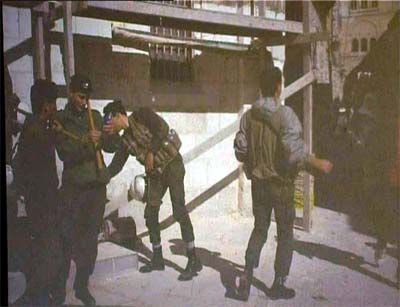
[45:20] This is inside Jerusalem - the occupation - where israeli soldiers can beat up anybody or strip anybody and arrest anybody
No Fear
'This anxious Palestinian mother had to go to the Israeli Security to ask for the release of her nine-year-old son, who'd been captured for throwing stones. Not so long ago, the boy's father was detained by the Israelis, and he was still on the wanted list. So the boy's father couldn't go to claim his son, and had to send his wife instead. She was a teacher. The Israelis told her, "You're a teacher. You mustn't teach your nine-year-old son to hate." She replied, "A nine-year-old should never hate anyone. The occupation taught him to hate the soldiers, I did not teach him that. Remove the occupation, and let my son learn to love your people."
'Palestinian kids appeared all over the place, making victory signs with their wee hands. The kids knew no fear. The Israelis arrested a three-year-old boy for throwing stones, and they threatened him: "You're only three and shouldn't know how to throw stones at us. Someone must have taught you. Tell us who taught you, or else..." The little boy replied, "My brother." That was it. Fully-armed Israeli soldiers picked up the toddler and stormed into his home looking for his brother. They found him in a corner playing - he was only one year older than his baby brother!'
Mike Holmes, a Scottish member of MAP, related the above incidents from his first trip to the Occupied Territories in early 1988 (during the first Intifada), from p287-288 of the book "From Beirut To Jerusalem".
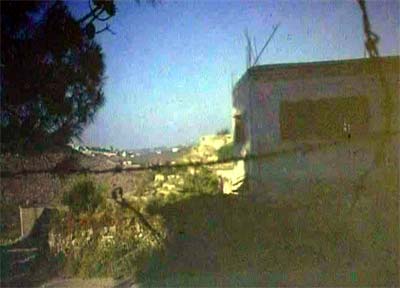
[45:35] Curfews - Barbed wires sealing up whole villages, denying them any right of leaving the village. Even locking up the windows for days and days. There is no need to have a reason to put a curfew on a village - you just declare a curfew so everybody will be packed in to their houses - they cannot look out, children cannot laugh and then Israelis just go in to the houses and arrest anybody they like or demolish a house - blow it up. That is curfew.
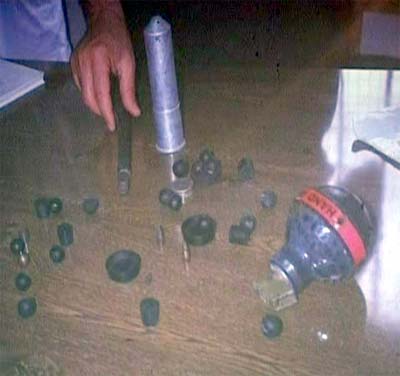
[46:05] When they talk about rubber bullets, plastic bullets, tear gas - they all kill! Now days the Israelis dont even use these, since the second Intifada they use live bullets..
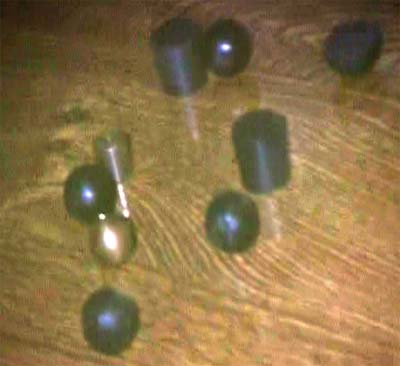
[46:30] Rubber bullets is actually metal - I've taken out the rubber coating on one of them so its solid metal - if you fire point blank it can actually kill someone. Tear gas shot in to a crowded place like this with no where to escape can kil a whole lot of people.
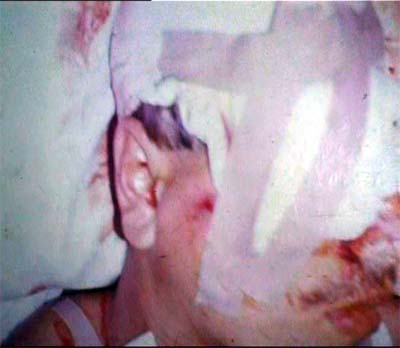
[46:50] These people [including the child below] were shot with a rubber bullet - the x-ray showed the metal bullet in the head.
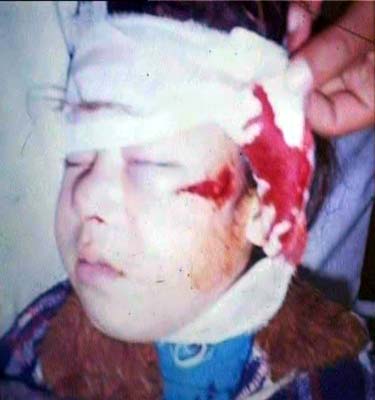
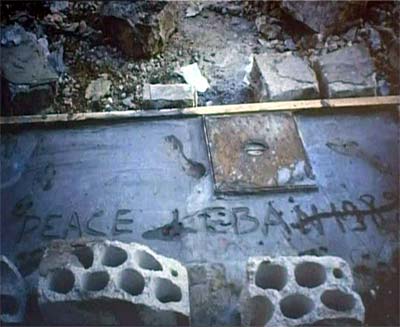
[49:10] Our western media talks about peace, but they have forgotten the main ingredient of peace which is justice. I've known this for a long time. This was peace - lebanon 1982. After the Israeli invasion of Lebanon there were five peace plans. All of them failed because none of the peace plans talked about justice. And today - the same, people talk about peace - the road map and so on - but which one of them talks about justice? Certainly there can be no peace without justice...
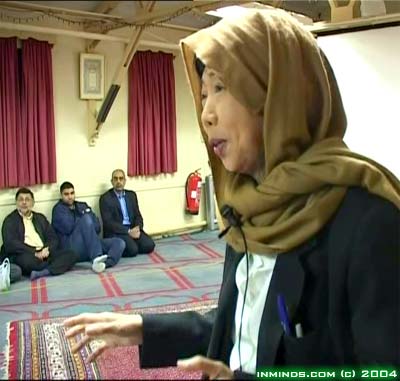
A Question and Answer session followed the talk.
Links
 International Campaign for Justice for the Victims of Sabra & Shatila- website for the case lodged in Belgium against Israeli Prime Minister Ariel Sharon and others responsible for the massacre. International Campaign for Justice for the Victims of Sabra & Shatila- website for the case lodged in Belgium against Israeli Prime Minister Ariel Sharon and others responsible for the massacre.
 Medical Aid For Palestinians (MAP)- charity set up by Dr Ang Swee Chai with her husband Francis Khoo and some friends. Medical Aid For Palestinians (MAP)- charity set up by Dr Ang Swee Chai with her husband Francis Khoo and some friends.
 From Beirut To Jerusalem- book by Dr Ang Swee Chai, available from MAP- you've read the extracts from it, now get the book. From Beirut To Jerusalem- book by Dr Ang Swee Chai, available from MAP- you've read the extracts from it, now get the book.
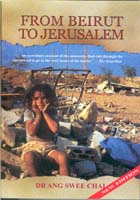
 Khiam Prison - Israels Torture Den- an account of the notorious Israeli prison in South Lebanon where thousands of Lebanese were caged, tortured and some murdered. Khiam Prison - Israels Torture Den- an account of the notorious Israeli prison in South Lebanon where thousands of Lebanese were caged, tortured and some murdered.
|
